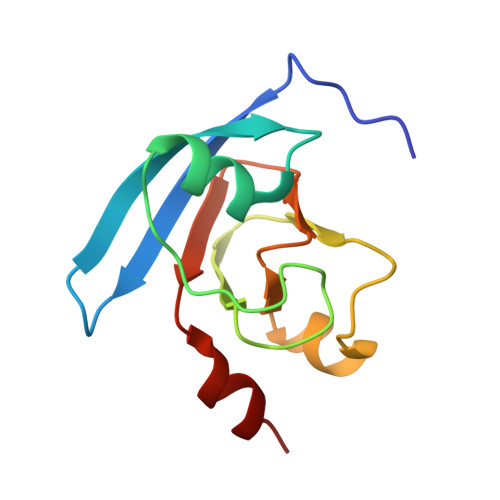An alternative plant-like cyanobacterial ferredoxin with unprecedented structural and functional properties.
Motomura, T., Zuccarello, L., Setif, P., Boussac, A., Umena, Y., Lemaire, D., Tripathy, J.N., Sugiura, M., Hienerwadel, R., Shen, J.R., Berthomieu, C.(2019) Biochim Biophys Acta Bioenerg 1860: 148084-148084
- PubMed: 31520614
- DOI: https://doi.org/10.1016/j.bbabio.2019.148084
- Primary Citation of Related Structures:
6IRI, 6JO2 - PubMed Abstract:
Photosynthetic [2Fe-2S] plant-type ferredoxins have a central role in electron transfer between the photosynthetic chain and various metabolic pathways. Several genes are coding for [2Fe2S] ferredoxins in cyanobacteria, with four in the thermophilic cyanobacterium Thermosynechococcus elongatus. The structure and functional properties of the major ferredoxin Fd1 are well known but data on the other ferredoxins are scarce. We report the structural and functional properties of a novel minor type ferredoxin, Fd2 of T. elongatus, homologous to Fed4 from Synechocystis sp. PCC 6803. Remarkably, the midpoint potential of Fd2, Em = -440 mV, is lower than that of Fd1, Em = -372 mV. However, while Fd2 can efficiently react with photosystem I or nitrite reductase, time-resolved spectroscopy shows that Fd2 has a very low capacity to reduce ferredoxin-NADP + oxidoreductase (FNR). These unique Fd2 properties are discussed in relation with its structure, solved at 1.38 Å resolution. The Fd2 structure significantly differs from other known ferredoxins structures in loop 2, N-terminal region, hydrogen bonding networks and surface charge distributions. UV-Vis, EPR, and Mid- and Far-IR data also show that the electronic properties of the [2Fe2S] cluster of Fd2 and its interaction with the protein differ from those of Fd1 both in the oxidized and reduced states. The structural analysis allows to propose that valine in the motif Cys 53 ValAsnCys 56 of Fd2 and the specific orientation of Phe72, explain the electron transfer properties of Fd2. Strikingly, the nature of these residues correlates with different phylogenetic groups of cyanobacterial Fds. With its low redox potential and its discrimination against FNR, Fd2 exhibits a unique capacity to direct efficiently photosynthetic electrons to metabolic pathways not dependent on FNR.
Organizational Affiliation:
Research Institute for Interdisciplinary Science, Graduate School of Natural Science and Technology, Okayama University, Okayama 700-8530, Japan.
















